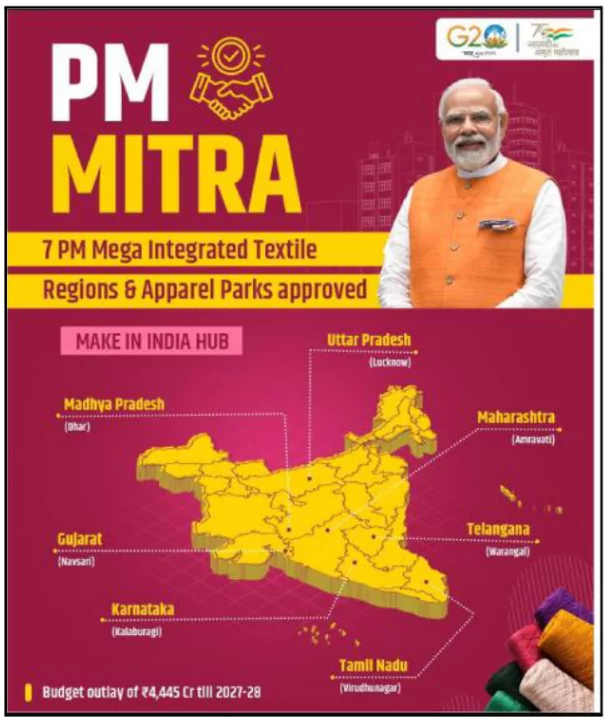Madhya Pradesh has received formal approval for the ₹2,100 crore PM MITRA textile park project in Bhainsola village, Dhar district, aiming to revolutionize the state’s textile industry.
More on the Textile Park
- The PM MITRA Park in Madhya Pradesh will span an area of 2,100 acres and is expected to attract massive investments and generate significant employment opportunities.
- The project site in Dhar district is strategically near Indore, Pithampur industrial cluster, and the Delhi-Mumbai Expressway.
- It will include advanced infrastructure like a 20 MLD Zero Liquid Discharge (ZLD) plant, a solar-powered energy facility, and plug-and-play units.
About PM MITRA Scheme
- The PM MITRA (Mega Integrated Textile Region and Apparel) Scheme aims to transform India into a global textile manufacturing and export powerhouse.
- Origin: The scheme is inspired by Prime Minister Narendra Modi’s 5F vision: Farm to Fiber to Factory to Fashion to Foreign.
 Time Period: 2021-22 to 2027-28
Time Period: 2021-22 to 2027-28- Objective:
- To develop world-class textile infrastructure;
- reduce logistics costs;
- enhance the competitiveness of the Indian textile industry.
About PM MITRA Textile Park Project
- PM MITRA Parks will establish integrated textile value chains at a single location, covering all processes from spinning to garment manufacturing.
- MITRA parks can be either Greenfield or Brownfield.
- Components: Each park will feature core infrastructure like an incubation center, developed factory sites, roads, power, water systems, and common processing facilities.
- Parks will also include worker residential complexes and offer green energy solutions like solar power units
- Approved Parks: Seven PM MITRA Textile Parks have been approved in Bhainsola, Dhar (Madhya Pradesh), Virudhunagar (Tamil Nadu), Amravati (Maharashtra), Navsari (Gujarat), Lucknow-Hardoi region (Uttar Pradesh), Warangal (Telangana), and Kalaburagi (Karnataka).
- Execution: A Special Purpose Vehicle (SPV) jointly owned by the Centre and State Governments will oversee project execution.
- SPV is a separate legal entity created by a company, government, or group of investors to isolate financial risk or manage a specific project.
- It has its own assets, liabilities, and legal status, and is often used for large projects like infrastructure development, asset securitization, or investment purposes.
PWOnlyIAS Extra Edge
- Greenfield Sites: These are new, independent sites where the entire infrastructure will be built from scratch.
- Brownfield Sites: These are sites that already have some existing infrastructure, like industrial trunk infrastructure, and the PM MITRA scheme aims to complete the development of these sites
|
- Financial Support Under PM MITRA
- The Ministry of Textiles will offer Development Capital Support (DCS) of up to ₹800 crore for Greenfield parks and up to ₹500 crore for Brownfield parks.
- A Competitive Incentive Support (CIS) of up to ₹300 crore per park will promote early operationalization and scaling up.
- Commercial Development (CD) on up to 10% of park areas will be allowed to support financial viability and asset maintenance.
- Significance:MITRA Parks will reduce production costs, speed up manufacturing, and position India as a strong player in the global textile market.
Status of Indian Textile Industry
- Economic Contribution: The textile and apparel sector contributes 2.3% to India’s GDP, 13% to industrial production, and 12% to the country’s total exports.
- Export Performance: India exported textile goods worth US$ 34.4 billion in 2023–24, with apparel accounting for 42%, raw/semi-finished materials 34%, and non-apparel finished goods 30%.
- Employment Generation: The industry directly employs over 45 million people, including a significant number of women and rural workers, making it the second-largest employer after agriculture.
- Alignment with Government Initiatives: The sector supports Make in India, Skill India, Women’s Empowerment, Rural Youth Employment, and promotes inclusive growth through MSME-driven manufacturing.
- Growth Prospects: With annual garment production of 22,000 million pieces, the market is projected to grow from US$ 174 billion to US$ 350 billion by 2030.
|
![]() 28 Apr 2025
28 Apr 2025

 Time Period: 2021-22 to 2027-28
Time Period: 2021-22 to 2027-28